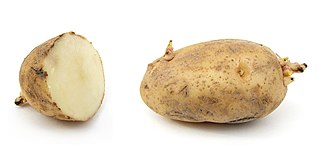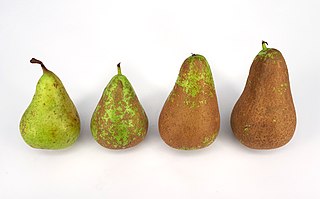Related Research Articles

The potato is a starchy root vegetable native to the Americas that is consumed as a staple food in many parts of the world. Potatoes are tubers of the plant Solanum tuberosum, a perennial in the nightshade family Solanaceae.

The sweet potato is a dicotyledonous plant that belongs to the bindweed or morning glory family, Convolvulaceae. Its large, starchy, sweet-tasting tuberous roots are used as a root vegetable. The young shoots and leaves are sometimes eaten as greens. Cultivars of the sweet potato have been bred to bear tubers with flesh and skin of various colors. Sweet potato is only distantly related to the common potato, both being in the order Solanales. Although darker sweet potatoes are often referred to as "yams" in parts of North America, the species is even more distant from the true yams, which are monocots in the order Dioscoreales.

Pyrus pyrifolia is a species of pear tree native to southern China and northern Indochina that has been introduced to Korea, Japan and other parts of the world. The tree's edible fruit is known by many names, including Asian pear, Persian pear, Japanese pear, Chinese pear, Korean pear, Taiwanese pear, apple pear, zodiac pear, three-halves pear, papple, naspati and sand pear. Along with cultivars of P. × bretschneideri and P. ussuriensis, the fruit is also called the nashi pear. Cultivars derived from Pyrus pyrifolia are grown throughout East Asia, and in other countries such as India, Pakistan, Nepal, Australia, New Zealand, and the United States. Traditionally in East Asia the tree's flowers are a popular symbol of early spring, and it is a common sight in gardens and the countryside.

The J. R. Simplot Company is an agribusiness company headquartered in Boise, Idaho.

A russet potato is a type of potato that is large, with dark brown skin and few eyes. The flesh is white, dry, soft, and mealy, and it is suitable for baking, mashing, and french fries. Russet potatoes are sometimes known as Idaho potatoes in the United States, but the name Idaho Potato is trademarked by the Idaho Potato Commission and only potatoes grown in the state of Idaho can legally be referred to by that name.

Russet Burbank is a potato cultivar with dark brown skin and few eyes that is the most widely grown potato in North America. A russet type, its flesh is white, dry, and mealy, and it is good for baking, mashing, and french fries (chips). It is a common and popular potato.

Yukon Gold is a large cultivar of potato most distinctly characterized by its thin, smooth, eye-free skin and yellow-tinged flesh. This potato was developed in the 1960s by Garnet ("Gary") Johnston in Guelph, Ontario, Canada, with the help of Geoff Rowberry at the University of Guelph. The official cross bred strain was made in 1966 and 'Yukon Gold' was finally released into the market in 1980.
The Alaska Agricultural and Forestry Experiment Station (AFES) was established in 1898 in Sitka, Alaska, also the site of the first agricultural experiment farm in what was then Alaska Territory. Today the station is administered by the University of Alaska Fairbanks through the School of Natural Resources and Agricultural Sciences. Facilities and programs include the Fairbanks Experiment Farm, the Georgeson Botanical Garden, the Palmer Research and Extension Center, the Matanuska Experiment Farm, and the Reindeer Research Program.

The Knobby Russet, also known as Knobbed Russet, Winter Russet, Old Maids, and Winter Apple, is a large green and yellow apple cultivar with a rough and black russet and unusually irregular, warty, and knobbly surface. It has a soft and sweet creamy flesh and looks more like a potato than an apple. Knobby Russets are harvested in mid to late October and are in season between October and February/March.

The tomato is the edible berry of the plant Solanum lycopersicum, commonly known as the tomato plant. The species originated in western South America, Mexico, and Central America. The Nahuatl word tomatl gave rise to the Spanish word tomate, from which the English word tomato derives. Its domestication and use as a cultivated food may have originated with the indigenous peoples of Mexico. The Aztecs used tomatoes in their cooking at the time of the Spanish conquest of the Aztec Empire, and after the Spanish encountered the tomato for the first time after their contact with the Aztecs, they brought the plant to Europe, in a widespread transfer of plants known as the Columbian exchange. From there, the tomato was introduced to other parts of the European-colonized world during the 16th century.

Luther Burbank was an American botanist, horticulturist and pioneer in agricultural science. He developed more than 800 strains and varieties of plants over his 55-year career. Burbank's developments included those of fruits, flowers, grains, grasses, and vegetables. He developed a spineless cactus and the plumcot.
Butte is a potato cultivar that was released in 1977.
Alturas is a russet potato variety released in 2002 by the USDA-ARS and the Agricultural Experiment Stations of Idaho, Oregon, and Washington and it is under plant variety protection. It is a processing potato that has cold-sweetening resistance, so it can be processed directly out of storage into French fries and other frozen potato products.
Umatilla Russet is a moderately late maturing variety of potato especially suitable for frozen french fries processing. It was jointly released by the Agricultural Experiment Station of Oregon, Idaho, and Washington and the U.S. Department of Agriculture in 1998. 'Umatilla Russet' has been equal to or better than Russet Burbank in fry color in Oregon and regional trials. The potato was named by the state of Oregon after the Umatilla tribe, from which the city of Umatilla also takes its name.
The Ranger Russet is a late-maturing potato that is used for baking and processing into fries. It was originally bred by Joseph J. Pavek of the USDA in Aberdeen, Idaho, and released jointly by the USDA and the agricultural stations of Idaho, Washington, Oregon and Colorado in 1991. Ranger Russet is not under plant variety protection. It yields medium to high numbers of tubers with a short dormancy period.

A genetically modified potato is a potato that has had its genes modified, using genetic engineering. Goals of modification include introducing pest resistance, tweaking the amounts of certain chemicals produced by the plant, and to prevent browning or bruising of the tubers. Varieties modified to produce large amounts of starches may be approved for industrial use only, not for food.

Russeting or russetting is an abnormality of fruit skin which manifests in russet-colored (brownish) patches that are rougher than healthy skin. It is a common feature in apples and pears. Russeting is typically an undesirable trait, which reduces the storage life of fruits and makes their appearance unattractive to consumers, although some cultivars, so-called russet apples, are appreciated for the feature.

The Russian blue potato is a deep purple cultivar of potato believed to have originated in Russia.
References
- ↑ "Rainier Russet". pvmi.org. Retrieved 2023-05-18.
- ↑ "Two new spud varieties poised for release". Idaho Farm Bureau. Retrieved 2023-05-18.
- ↑ "2018 Potato Cultivar Yield and Postharvest Quality Evaluations" (PDF). wsu.edu. Retrieved 9 May 2024.
